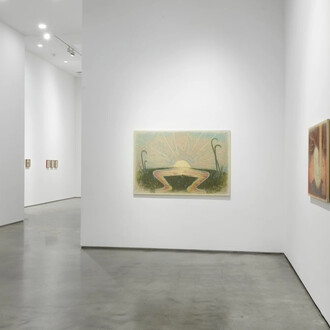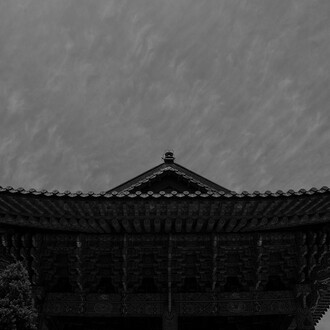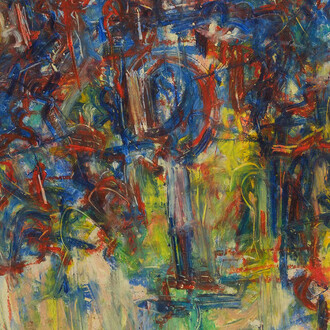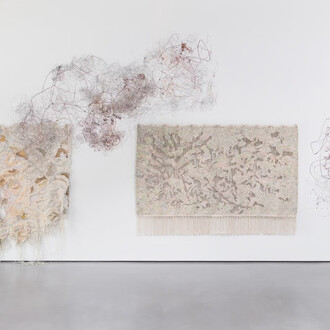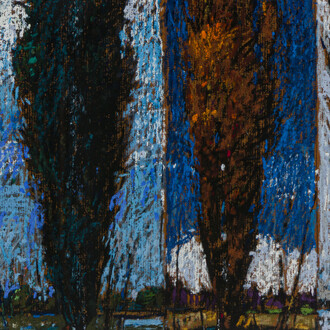When I’m in the studio, it’s as if I’m on sort of a backwards archeological dig—I physically apply layers of paint, continually adding and adjusting color, sometimes scraping it back to reveal former layers, then again adding and scratching through. While I’m doing this, I’m thinking about things from my past, from my life, from paintings I’ve previously made. I’m also imagining future selves, selves who will see this thing I’ve summoned from an interior space. I imagine the life of this artwork and wonder if future viewers discovering it will be able to understand the idiosyncrasies of its makeup, to unpick this physical representation and amalgamation of time, of life lived, of memory and imagination.
(Martyn Cross)
Marianne Boesky Gallery is pleased to present Softly radiant, half-buried, a group exhibition curated by artist Martyn Cross. With Softly radiant, half-buried, Cross brings together 15 artists whose work occupies a place beyond time, consciousness, and reality—artists with whom Cross feels an innate connection and who have served as points of inspiration and reflection as he works toward his next solo exhibition at Marianne Boesky Gallery, slated to open in October.
Softly radiant, half-buried borrows its title from critic Sanford Schwartz’s Artforum review of Arthur Dove’s 1976 retrospective at the Whitney Museum of American Art. In the review, Schwartz identified the difference between Dove and two of his peers: “If in John Marin’s mind,” Schwartz wrote, “it’s always one o’clock in the afternoon on a glitteringly bright day, a world without shadows, and Marsden Hartley is most himself when he conveys the threat and lordly grandeur of the world at night, Arthur Dove is the painter of the softly radiant, half-buried, in-between times.” Cross first encountered Dove’s work on a visit to the Whitney in 1997. Standing before Dove’s Ferry boat wreck (1931), Cross had an artistic epiphany: “There was a realization,” he says, “that I was connecting with a sensation felt by a long dead human; that space, time, and what I knew of as conscious thought, was somehow condensed within that painting and the air around it.”
For Softly radiant, half-buried, Cross brings together a group of artists who make work that, like Dove’s, lives in a fuzzy, interior space operating according to ecological or geological laws of accumulation and erosion. Like rock formations, art is a record of time—time spent not only in the active process of making, but in thinking and looking and reading and contemplating. In their imagery, the artists of Softly radiant, half-buried mine the depths of the creative process, allowing the evidence of this approach to bubble up to the surface, producing a visual testimony to the unknown, unspeakable—but deeply felt—places from where their art arises.
The work of artists Gertrude Abercrombie, Paul Becker, Daisy Scheff, Clayton Schiff, Emma Talbot and Hannah van Bart occupies a subtle psychological space–at once intimately familiar and acutely unknowable. Throughout her surreal, psychic landscapes, Gertrude Abercrombie (American; 1909–1977) probes the mind’s conscious and unconscious states. Drawing on fin de siècle visual tropes, Paul Becker (b. 1967; London, UK) imagines chimerical figures amidst continual transformation, their illusory qualities renewed upon each viewing. Upon close inspection, a distinct sense of alienation and anxiety emerges from the dream-like, seemingly humorous paintings of Clayton Schiff (b. 1987; New York, NY). Embracing the absurd, Daisy Sheff (b. 1996; Greenbrae, CA)renders private domestic interiors that operate according to an otherworldly logic. With explicit references to the myth of Persephone and her cyclical return from the underworld, Emma Talbot (b. 1969; Stourbridge, UK) examines the psychological process of regrowth from grief. Articulating the physical and emotional contours of her landscapes with remarkable psychological depth, Hannah Van Bart (b. 1963; Oud-Zuilen, Netherlands) constructs settings from imagination and feelings from memory.
Arthur Dove, Aimée Parrott, Thom Trojanowski, and Co Westerik connect sensorially with their lived environment, seemingly extracting the inner essence of the ecologies in which they find themselves. Employing an abstracted, organic vocabulary, the paintings of Arthur Dove (1880-1946) hold a deep affinity with nature and the American landscape. In paintings that seem to transform before the viewer’s eyes, Aimée Parrott (b. 1987; Brighton, UK) considers the interconnectivity of all living things and the relationship of macro and micro. Merging the autobiographical with elements of folklore and mythology, Thom Trojanowski (b. 1988; Kidderminster, UK) depicts the complex symbiotic relationship between people and nature. In his quest to visualize an inner territory, Co Westerik (Dutch; 1924–2018) examines the underlying strangeness of ordinary things and the conflicts between body and vegetation.
David Altmejd, Lonnie Holley, Paul Johnson, Bridget Mullen, and Tom Woolner conceptualize time and space according to notions of the geological. The hallucinatory, post-apocalyptic work of David Altmejd (b. 1974; Montreal, Canada) embraces charged elements of animal, vegetable, and mineral to examine decay, transformation, and regeneration. Arising from the materiality of the earth and its waste, the work of Lonnie Holley (b. 1950; Birmingham, AL) captures the autobiographical and collective history of our ancestors. Made according to a custom, near-geological process created by the artist, the plastiglomerate works of Paul Johnson (b. 1972; London, UK) reveal the intricate layering of a terraform object. The psychedelic compositions of Bridget Mullen (b. 1976; Winona, MN) examine the slippage and elastic passing of time through the geology of the body. Bringing his alternative landscapes into existence in reverse, Tom Woolner (b. 1979; London, UK) engages intuitive pouring, piping and squidging, allowing materials to merge into—rather than onto—his surfaces.
Dove, Schwartz writes later in the same 1976 review “understands the connections and balances between things—the overtones, echoes, shadings, reverberations and glimmerings—more than the things themselves.” The same is perhaps true of the artists of Softly radiant, half-buried, a group of artists more interested in becoming than in being, more concerned in transformation than stasis. Diving into the depths of their inner worlds, these artists pull forth the “amalgamation of time, of life lived, of memory and imagination,” making physical these worlds for the future to find.






